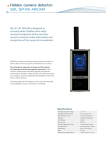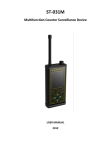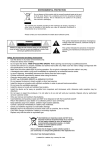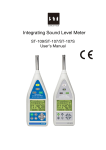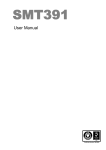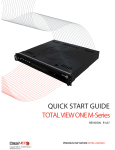Download ST 107 EMF DETECTOR
Transcript
ST 107 EMF DETECTOR TECHNICAL DESCRIPTION AND USER’S GUIDE 1. Introduction This User’s Guide contains information necessary for the setup and operation of the ST 107 EMF (RF) Detector. Before operating your ST 107, read this User’s Guide carefully and consult it every time you have questions about the operation of the EMF Detector. The information in this User’s Guide is subject to change without prior notice. The manufacturer has a right to change the product’s specifications in such a manner that they do not worsen or reduce the product’s functionality. 2. Purpose The ST107 EMF (electromagnetic field) Detector is designed to detect and locate the sources of electromagnetic radiation from devices intended for the unauthorized obtaining of information (eavesdropping devices), such as: —radio microphones; —telephone radio transmitters; —radio-stethoscopes; —hidden video cameras equipped with a radio channel for transmitting information;—radio beacons for tracking moving objects (people, vehicles, freights, etc.); —unauthorized use of GSM and DECT cellular phones; —unauthorized use of Bluetooth and 802.11g (WLAN, WiFi); The ST 107 will operate in accordance with its specifications if the battery voltage is no lower than 1.1 V. Operating temperature: –10º to 35º C (14º to 95º F). Relative humidity: up to 95% (noncondensing). Operating the device at temperatures below –5º C (23 F) will slow down the output of data to the display. WARNING! The output amplifier of the ST 107 may be damaged by: —high voltage from static electricity, which may accumulate on synthetic clothing, floor carpets, etc.); —sources of high-power electromagnetic interference in the vicinity of the ST 107. 3. Specifications Frequency range, MHz 50-7000 Channel 1, MHz 50-2500 channel 2, MHz (with SHF antenna ) 2500-7000 Frequency range 1 -75 (50MHz) -70 (1500MHz) -50 (2500MHz) Threshold Input sensitivity, dBm: 55 (50-2000MHz) 40 (2000-2500MHz) Display dynamic range, db Frequency meter sensitivity, dBm -35 (500MHz) -40 (1500MHz) -20 (2500MHz) Frequency measurement error,% 0.005 Low-pass filter cutoff frequency, MHz 750 Frequency range 2 Threshold Input sensitivity, W/cm2 Dynamic range, db (2-9)* 10-10 45 Power supply, V: internal Li pol battery external power supply/charger 3.6V 5 Current consumption, mA <80 Dimensions Prime Unit (without antennas), mm Dimension SHF antenna 85x53x19 D= 16, L=72 Weight Prime Unit (without antennas), kg 0.15 4. ST 107 box content 1.ST 107 EMF Detector Unit 2. UHF antenna 3. Charge/Power supply 4. Cable USB 5. Mini-CD 6. This User’s Guide 7. SHF antenna (optional) 5. Operating principles and brief reference The ST 107 utilizes the principles of wideband detection of electric fields. 5.1. Operating modes The ST 007 operates in three main modes: —Search; —Monitoring; —Log view. The device has a menu that allows for its configuration. 5.1.1 Search Mode This mode is intended for detecting sources of electromagnetic radiation. I n this mode, the ST 107 receives radio signals, detects them, and outputs them to the built-in display and as an audio signal to the earphones and the built-in speaker. The level of the signal is indicated on two 32-segment level meters on the display. Adjacent segments (9) light up to indicate the average value of the level of the detected signal, while a single lit up segment (7) shows its peak value. The ST 107 can measure current frequency values of the radio signal and determine its most stable value (for signals with a constant carrier frequency). The ST 107 also displays the detection of GSM, DECT, Bluetooth, and 802.11g (WLAN, WiFi) signals. 1 The number of displayed Bands /temporary indication of zero level of gauges 2 indicates the high-pass filter is on 3 32-segment meter indicating the level of Channel 1 4 32-segment meter indicating the level of Channel 2 5 current absolute value of the zero level of Band 1 dB 6 current absolute value of the zero level of Band 2 dB 5, 6 radio signal frequency 7 indicator the level of pulse power 8- type of detected signals 9 Indicator the level of integrated power 10 current range of level gauges 5.1.2. Monitoring Mode The Monitoring mode is intended for detecting sources of electromagnetic radiation and storing data in NVRAM. The maximum number of events that can be stored in NVRAM is 4,096. The events can be viewed when the detector is in the Log View mode. The Monitoring mode has an extended range of alarm signals, which can be triggered if the signal passes a certain level or frequency threshold, or if a certain type of signal is detected (GSM, DECT, Bluetooth, 802.11). It is possible for the user to schedule the ST 007 to turn on and off. This mode has two basic operations: 5.1.2.1. User controlled operation The ST 007 is placed so that it is visible to the user. This is useful for detecting devices for the unauthorized obtaining of information among the visitors of an office, for example. 5.1.2.2. Autonomous operation The ST 007 is placed in an area where the use of eavesdropping devices is suspected, and the electromagnetic environment will be monitored during a preprogrammed period without user interference. 1, 3 indicators the level of integrated power in the 1 and 2 Channels 2. 4 threshold level markers of integrated power: when the level exceeds the set threshold level, the event is logged in the protocol (set via the menu) 5 type of detected signal: DECT, GSM. Bluetooth, and 802.11 and signal frequency in the XXXX.XX MHz format. 6,7 indicators the level of pulse power in the first and in the second frequency range. 8,9 threshold level markers of pulse power: when the level exceeds the set threshold level, the event is logged in the protocol (set via the menu). 5.1.3. Protocol View mode The Protocol View mode is intended for viewing the log of events stored in the ST 107’s NVRAM during Monitoring. Events can be sorted by: —time; —duration; —signal level; —frequency value. 1 memory bank number (1–9) 2 current event number (001–999) 3 total number of events in the bank (001–999) 4 event duration (hours:minutes, max, 99:59) 5 event beginning time (hours:minutes) 6 date of the event (day and month) 7 threshold level markers 8 signal type (DECT, GSM, Bluetooth, 802.11) 9 signal levels of the event. 5.1.4. Menu. Custom settings. The ST 107 can be custom configured through the menu, if you choose to override factory defaults. 5.2. Description of the box contents 5.2.1. ST 007 EMF Detector The ST 007 EMF Detector is a small form-factor box. On the front panel of the detector: a graphical display and six-button thin film keypad. The top of the detector has a ports for connecting a UHF and SHF antennas. The left side of the detector has a 3.5 mm earphones jack and USB port. The back of the detector has a sticker with information about the manufacturer, model, and serial number; 5.3. Packaging The ST 107 and its accessories are shipped in a box made of corrugated cardboard with the dimensions of 170 x 150 x 60 mm (6.7 x 6 x 2.4 in.). For convenience, as well as to prevent the sliding of the contents, the detector and its accessories are placed in a specially molded styrofoam insert. 6. Operating the ST 107 WARNING! This User’s Guide describes the principles of operating the ST 107. It is not intended as a comprehensive reference for detecting eavesdropping devices. 6.1. Display and controls 6.1.1. Display The results of are indicated a four-line LCD with a resolution of 97 x 36 pixels as digits and text, as well as additional pictograms at the top of the display. Fig. 3 shows the elements of the display, typical for all the modes of operation: 1—battery level/AC; 2—indicates that data is transmitted through the USB port; 3—volume level; 4—indicates that scheduling is on for the Monitoring mode; 5—real-time clock (hours:minutes) 6—indicates that audio signaling is off; 7—operation mode status ` Fig 3 L—Log View mode. 6.1.2. Controls The ST 107 is controlled from a six-button thin film keypad. 6.1.2.1. Turning the detector on and off To turn the ST 107 on press <MODE>. The following will temporarily appear on the display: SmerSH Technics Russia 2009 Ver. X.X www.spymarket.com, where X.X. is the detector’s firmware version number. By default, after powering on, the ST 107 enters the <SEARSH> mode. To turn the detector off manually, press <MODE>. “Power off” will be displayed for three seconds, after which the ST 107 will turn off. (If scheduling was set up for the Monitoring mode, the display will show pictogram 4 and the current time 6.) When in the Search mode, the detector will turn off automatically, depending on the idle time value set (i.e. time after the last key has been pressed) in the Menu. The ST 107 will not turn off automatically if used with the power supply. 6.1.2.2. Control buttons explained Button Main function Text color White Chooses Search, Monitoring, and turns the detector on and off. PWR/MODE ZERO SENS/ EXIT VOL+ VOL– MENU ENTER SEARCH Mode->Power off>MONITORING mode->Power off Secondary function Used for setting the detector via Menu Yellow - Sets indication threshold level in SEARCH mode Up one menu level Sets sensitivity level for display gauges Exit from the menu Adjusts volume Moves up and down in the menu Enter in MENU Confirms selection 6.1.2.3. Volume control Pressing the Vol– and Vol+ buttons adjust the volume and indicates its level on pictogram 3. 6.2. Power supply The ST 107 can be powered by - a built in Li – Pol Battery ; external charger/power supply (included); USB port of PC. When the batter discharges to the minimum battery level the indicator 1 (Fig. 3) will turn from solid to outline and will be begin blinking. Average battery operation time of no less than 8 hours. To extend the built-in battery life, we recommend avoiding the situation when it is completely discharged. In Monitoring Mode we recommend using the detector with the external power supply. It is safe for the data and settings to leave the device out of power for extended periods of time. All information is stored in the device’s NVRAM and will not be lost if the device loses power or the battery runs out in the middle of operation. 6.2.1. Charging the Battery Connect the charger to the USB port on the ST 107. Connect the charger to an 220 V electric outlet. “Battery Charging” will appear on the display. When the battery is fully charged, the display will indicate “Battery Charged.” It takes approximately 2.5 hours to charge the battery to 100 per cent. If the device operates from the power supply, or whenever it is connected to a powered USB port on the computer, the battery will be charging automatically. In this mode it will take approximately 12 hours to completely charge the battery. When the battery is fully charged and the detector continues to operated from the power supply, pictogram 1 will disappear from the display. 6.3. Preparing ST 107 for operation - connect the UHF and SHF (optionally) antennas to the detector unit; - turn the detector on by pressing «MODE». When the unit powers up, it automatically enters the SEARCH mode; - if the text “Battery Discharged” appears on the display, you will need to charge it. - set the time on the detector’s internal clock. For more information on setting the time, see 6.7. 6.4. SEARSH mode 6.4.1. Controls Operating the detector using the keypad: To set the indication threshold of the signal compared to the current level of the radio signal press ZERO once. The display will temporarily indicate “Zero” , all the gauges will be cleared, and the current level of the signals in dB will be displayed in 5 (BAND 1) and 6 (BAND 2). After each subsequent setting of the threshold level, the scale of the gauges will change according to the remainder. For example, if the absolute value of the zero level is 24 dB, the entire meter will be linear in the range between 24 dB and 56 dB (1 dB per segment); if the absolute value of the zero level is 8 dB, the entire meter will be linear in the range between 8 dB and 56 dB (1.5 dB per segment); etc. To set the indication threshold of the signal with zeroing the values in 5 and 6 press ZERO when you see “Zero” displayed . Setting the sensitivity of level gauges. Press SENS sequentially to cycle through the available sensitivity levels. The selected value will be displayed in 10: “L”—low sensitivity level, the entire meter spans out 55 dB; “M”—medium sensitivity level, the entire meter spans out 35 dB; “L”—high sensitivity level, the entire meter spans out 15 dB. 6.4.2. Usage Set the indication level threshold. You cannot set the threshold when in the room to be scanned. If eavesdropping devices are already present and operating in the room, their radiation level will be considered the “zero” level by the detector. When the antenna approaches a eavesdropping device, depending on the band of signal, the number of solid segments of one of the level gauges will increase When the signal level exceeds 32 dB, the detector will display the value of the signal’s detected frequency. To determine the precise location of the eavesdropping device, press ZERO to set the zero level to the current signal level and continue to scan the room. Repeat this until you locate the offending device. Change the sensitivity of the level gauges if necessary. To attenuate interference from powerful radio transmitters in the range up 900 MHz (base station of GSM and DECT), we recommend engaging the low-pass filter. 6.5. MONITORING mode To select the Monitoring mode, press Mode (see 6.1.2.2.). “Monitor Start” will be displayed and a five-second countdown will begin. This period is intended for measuring the background level, against which the ST 107 will compare all subsequent measurements. 6.5.1. Controls Use Menu to adjust the settings for this mode. In this mode, the following conditions are always true: —the range of the level gauges is 0 to 55 dB; —the ZERO and SENS are disabled. 6.5.2 Usage Adjust the settings in the Menu, if necessary. Place the ST 107 in the area where the presence of eavesdropping devices is suspected. If the alarm conditions are met, “Alarm” will be displayed. The ST 007 logs events of each monitoring session to a separate memory bank. The total number of memory banks is 9. Bank #1 always contains the most recent events; bank #9 has the oldest events. When all the memory banks are full, the events in bank #9 are deleted to make room for new events. The maximum number of events in one memory bank is 999. The total number of events that the ST 007 can hold is 4,096. The minimum time between two events of the same type is 1 seconds. Such events will be logged in the protocol as two separate records. If a second event of the same type is detected within 1 seconds, the ST 107 will not log it as a separate event. Instead, the duration of the previous even will be extended. 6.6. LOG VIEW mode If the log has no events, “Log Empty” will be displayed. 6.6.1 Controls To browse the events use the VOL+ VOL– buttons. The events are numbered according to the sort order (set via the Menu). To switch between the banks press SENS/EXIT. The bank with the latest information will always be bank №1. If you choose sorting order other than by time in the Menu, you may also see the following text: “Sorting. Please wait...” Pressing MENU will display the information about the cause of the event in the following format: 1— level XX dB 2—DECT, GSM, Bluetooth, 802.11 3—Captured frequency or frequency change = XXXX.XX MHz Only the fields that indicate the cause of the event are displayed. To exit the mode press SENS/EXIT. 6.7 Working with Menu The Menu is used to change the factory default settings of the ST 107 to suit your particular needs. To enter the Menu press MENU/ENTER. Four options are available under Menu: MONITOR - settings for the Monitor mode (see Table 2). LOG - settings for the Log View mode (see Table 3). SYSTEM - general system settings, such as backlight, time, language, etc. (see Table 4). CHANNEL- choice of displayed channels (1 or 2 or 1+2) and set of Filter. Use VOL+ and VOL– buttons to highlight a menu. To choose a menu press MENU/ENTER. To go up one level press ZERO. Press SENS/EXIT to exit the menu. Table 1. Search Option Frequency meter Diff mode Timer Description Default settings Set level—sets level at which the frequency meter will turn on, depending on the level of the upper meter (0 to 64 dB with 1 dB increments): 0 dB—always on, 64 dB—always off. Having the frequency meter off increases the battery life. 32 dB Capture level—sets stable level of signal frequency for display (0.1 to 1 % with 0.1 % increments). AOR model—chooses type of scanning device to transmit frequency data (AR-800, AR-8200, AR-5000) Averaging—sets averaging time (0.1 to 6 sec with 0.1 increments) Scale—sets scale for level meters (20 to 100 % for the entire meter with 10 % increments) Switch-off time—sets time for automatic switch off of the detector (in the Search mode) after the last keystroke (8 sec to 34 min with 8 sec increments). Only when operating from the battery. 0.5 % AR-8000 1 sec 40 % 30 min Table 2. Monitoring Option Event—sets the event to trigger logging Description Value Default settings Set relative level of ALARM. 1 to 64 dB with 1 dB increments. 20dB Capture of Frequency Set/Not set Set Signal GSM,DECT,BT,WLAN log events when signals are detected Set/Not set Set Set/Not set Set Set/Not set Not set Display only Only the “Alarm” text will be Alarm—sets displayed type of alarm Alarm hold signaling Alarm indication remains onscreen before any key is pressed. Sets time in hours (0–23) for automatic turning on the Monitoring Schedule—sets mode daily for a set period. monitoring Monitoring results for each sessions schedule are logged in a separate memory bank. Monitoring start time. By default 9 hours. Monitoring end time. Not set By default 17 hours. Table 3. Protocol Option Description Default settings By time—sorts events according to the time of occurrence. Set By level—sorts events by signal level as displayed by the top Sorting—sorts logged Not set meter in descending order. events according to one of the parameters By CHANNEL—sorts events by CHANNELs Not set By duration—sorts events by duration in descending order. Not set Erases all logged events. A confirmation dialog (“Are you sure?”) will be displayed. Press SENS/EXIT for yes, or any other button to cancel the operation. After all the events are erased, the “Logs are erased” text will be displayed. Erase all If you do not erase the logs manually, the bank with the oldest information will be automatically erased to make room for new events. Table 4 System settings Option Value Default settings Set/Not set Set Set/Not set Set Set/Not set Not set 10 to 100 % with 10 % increments 50 Sets time for automatic turning off of backlighting after a period of inactivity (8 sec to 2 min with 8 sec increments). 24 sec Sets display contrast (10 to 100 % with 10 % increments). 50 Language English/Russian Russian Date/Time Sets date and time. Hours (h), minutes (m), seconds (s), day (d), and month (M) are set separately. Press Enter to modify the next parameter. Set by user Set/Not set Set from –2 to +2 min with an accuracy of 1 sec per day. 00:00 Description Battery empty sound Repeated sound signals accompanying “Battery Empty” text on the screen. Button pressed sound Sound confirming that a button is pressed Backlight Sound Turns display backlighting on Backlight brightness Adjusts backlight brightness Display Timer Contrast Clock PC sync Automatically synchronizes with the clock on a PC during data transfer. Correction Sets daily clock correction Factory defaults Reverts ALL the settings of the detector to their factory defaults. Table 5 Channel Option Description Value Default settings channel 1 Set/Not set Set channel 2 Set/Not set Set On/Off Filter Set/Not set Not set Choice of a priority between measurements of frequency and identification of signals From 01- to 05 with increments of 01 03 choice of displayed channels Channel Freqmeter 7 Working with the Computer Before connecting the ST 107 to the computer, install the software from the Mini CD or download the latest version from the Internet at www.smersh.ru/manual/st107. Connect the ST 107 to the computer with the USB cable. When prompted to install the device driver choose the installation path. Confirm the installation by agreeing with the prompt. 7.1 “ST 107 PC DATA” Software The software is intended to: —display real-time data and the results of operation of the ST 107; —load and display textual and graphical information of the operation of the ST 107 in Monitoring Mode (Event Log); —operate the device remotely from the PC. The complete manual on the ST 107 PC DATA software is included on the Mini CD. 7.2 Downloading firmware updates from the Internet Navigate your web browser to http://www.spymarket.com/manual/st107.shtml WARNING! The following steps for updating the firmware in the ST 107 are true for Microsoft Internet Explorer™. The procedures for other web browsers may be different from those described below. Click the appropriate firmware version. You will be presented with the following prompt: “Would you like to open the file or save it to your computer?” Choose Open and within a few seconds the application will be downloaded and launched. Connect the ST 107 to a free USB ports of your PC. Press PWR/MODE. Monitor the updating process on your computer display. If this process fails, the application will offer you to attempt updating the ST 107 again. You can copy the downloaded updater application to any portable media and use it on another PC. 8. Some limitations and recommendations 8.1. Use the original packaging for storing and transporting the ST 107. If you are not using the unit for a prolonged period of time, keep it in a closed, heated room with a temperature of 10 to 35ºC (50º to 95º F) and relative humidity of no more than 80 %. When transporting the unit in the original packaging, take measures to prevent it from blows or excessive pressure. 8.2. After the unit has been exposed to temperatures below –5ºC (23º F) for prolonged periods (over 4 hours), turn it on only after making sure there are no visible traces of condensation. 8.3. When operating the unit, try to protect it from concentrated moisture (rain, drizzle, and snow). Prevent the LCD from prolonged exposure to direct sunlight. 9. Warranty information 9.1. The manufacturer guarantees that the ST 107 will comply with the specifications for a period of 12 months beginning from the day of purchase. 9.2. The manufacturer will carry out repairs of the unit and its accessories or replace them if they malfunction or if the functioning will not comply with the stated specifications free of charge during the guarantee period. 9.3. This warranty only covers free-of-charge repair or adjustment of faults that are not the result of improper use, failure to follow the usage tips and recommendations stated in the User’s Guide, improper storage or shipment, and mechanical damage to the unit or its parts. The warranty will only be ensured with a guarantee claim accompanied by a properly filled out certificate of warranty. 9.4. The warranty is granted for every unit only if the purchaser provides a certificate of warranty filled out by the manufacturer and the seller. 9.5. The manufacturer offers post-guarantee servicing of the ST 107. SmerSH Technics grants its official dealers the right to establish additional warranty periods. 10. Quality control certificate The ST 107 EMF detector S/N____, has passed Q.C. Manufacture date:____ Certificate of warranty #1 For warranty repair (servicing) of the ST 007 EFM Detector S/N___ Manufacture date__ Manufacturer Sold (name of the dealership or trade organization) Date Sales representative (signature) Seller Certificate of warranty #1 (tear off part) For warranty repair (servicing) of the ST 007 EFM Detector S/N___ accepted__ service technician (name and signature) Toggles the low-pass filter on and off in Search mode Enters the Protocol View mode Engaging/disengaging the low-pass filter. To toggle the low-pass filter on and off press and hold Sens/UHF for more than two seconds. The state of the mode will be reflected in 10. The default state is OFF. Choosing audio signaling type. To choose between two types of audio signaling press Sound/Prt. When you choose “Tone” (see 1 on the display), clicks with a frequency proportional to the level of the detected signal will be heard through the built-in speaker and earphones. The higher the signal level the more rapid the clicks you will hear. The audio signaling is triggered as soon as the signal level reaches the fifth segment of the meter. If you choose “Aud,” you will hear an audio signal demodulated by the amplitude detector instead of clicks. The default setting is “Aud.”













